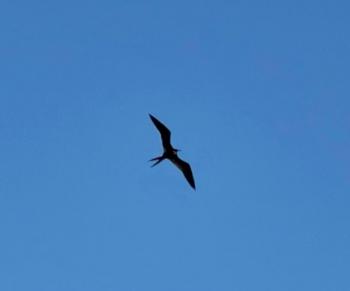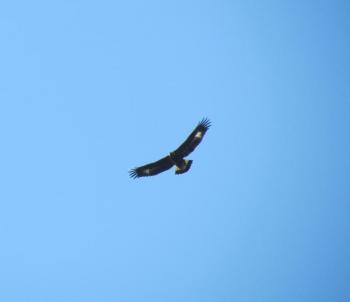A “Magnificent” Visitor
The Steller’s sea-eagle has certainly been a preoccupation of many over the recent weeks since it first made its appearance here in Maine. The odd, special, and unusual always capture the attention of humans in any context—bird enthusiasts are no different.
That was why a couple from Matinicus Island on their daily walk noticed and photographed a bird they had never seen before soaring over the harbor. They sent us the photo and asked if we could identify it.
We were shocked!
The long, black wings and forked tail of this large bird were unmistakable: magnificent frigatebird! That’s a bird of tropical seas that only rarely makes it north of coastal central Florida. We’re used to seeing them soaring over aqua blue seas from places like Aruba, Curaçao, and Bonaire.
There are a handful of records of the species in Maine. All are from coastal locations, often islands, but all have been from the relatively warm months from May through September. Although frigatebirds are experts at stealing food from other seabirds, surely the food one might steal from herring gulls on the Maine coast in winter would be a far cry from what it would be securing from a laughing gull or a brown pelican in Florida or Aruba!
Interestingly, a magnificent frigatebird was found on Nantucket Island, Massachusetts, on January 2. Comparisons of the photos so far have not been definitive as to whether it is the same bird as the one that showed up on Matinicus. There is some indication that winds or weather might have pushed multiple birds out of range as a magnificent frigatebird surprised birders way out on Bermuda on January 18 after a gale pushed through.
At last word, the Matinicus Island magnificent frigatebird had not been spotted again nor had it been reported by any of the hundreds of birders searching for the Steller’s sea-eagle, which moved over to Pemaquid Harbor for a few days before returning back to Boothbay. We hope the frigatebird made it back to warmer climes.
The many eyes scanning the skies and waters off Pemaquid and Boothbay may not have found any frigatebirds, but other rather unusual (even if not super rare like sea-eagles and frigatebirds) birds have been noted. One or more golden eagles have been seen over Boothbay and Pemaquid. We were among the fortunate ones to see one when we joined the birding horde at Pemaquid Harbor for a few hours on Saturday afternoon. Another notable bird that was there in the harbor was a dovekie, a tiny relative of puffins and guillemots that breeds way up in the High Arctic of Greenland and Baffin Island. Typically, a bird that winters well offshore, in occasional winters a few dovekies will end up inshore and thus they can be more easily seen. This one was diving regularly between the boats, hopefully finding some sustaining food along with the many long-tailed ducks, eiders, goldeneye, bufflehead, guillemots, and loons that were also roaming around the harbor.
If you are wondering, the Steller’s sea-eagle apparently had heard we were coming. According to the assembled birders, it disappeared over the ridgetop back toward Boothbay about twenty minutes before we arrived at Pemaquid Harbor!
But it sure is giving us lots of wonderful excuses for visiting some of our favorite parts of the Maine coast.
Jeffrey V. Wells, Ph.D., is a Fellow of the Cornell Lab of Ornithology and Vice President of Boreal Conservation for National Audubon. Dr. Wells is one of the nation's leading bird experts and conservation biologists and author of the “Birder’s Conservation Handbook.” His grandfather, the late John Chase, was a columnist for the Boothbay Register for many years. Allison Childs Wells, formerly of the Cornell Lab of Ornithology, is a senior director at the Natural Resources Council of Maine, a nonprofit membership organization working statewide to protect the nature of Maine. Both are widely published natural history writers and are the authors of the popular books, “Maine’s Favorite Birds” (Tilbury House) and “Birds of Aruba, Bonaire, and Curaçao: A Site and Field Guide,” (Cornell University Press).































